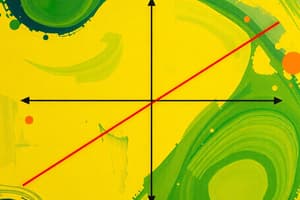Podcast
Questions and Answers
What does Cost Analysis study in relation to production?
What does Cost Analysis study in relation to production?
- Consumer preferences
- Economic stability
- Behavior of Cost (correct)
- Market competition
Which of the following costs are recorded in the books of accounts by a firm?
Which of the following costs are recorded in the books of accounts by a firm?
- Economic Costs
- Opportunity Costs
- Implicit Costs
- Accounting Costs (correct)
What does Economic Cost include in addition to Accounting Cost?
What does Economic Cost include in addition to Accounting Cost?
- Pure profit
- Implicit Cost (correct)
- Sunk cost
- Environmental costs
Which of the following is an example of Outlay Cost?
Which of the following is an example of Outlay Cost?
Opportunity Cost is defined as what?
Opportunity Cost is defined as what?
Which type of cost includes the normal return on money capital invested by an entrepreneur?
Which type of cost includes the normal return on money capital invested by an entrepreneur?
Which of the following costs would typically be excluded from long-term cost calculations?
Which of the following costs would typically be excluded from long-term cost calculations?
Which cost type does NOT typically appear in accounting records?
Which cost type does NOT typically appear in accounting records?
What happens to Average Cost when Marginal Cost is above it?
What happens to Average Cost when Marginal Cost is above it?
At what point does Average Cost reach its minimum?
At what point does Average Cost reach its minimum?
What characterizes the Long Run in production?
What characterizes the Long Run in production?
What does the Minimum Efficient Scale refer to?
What does the Minimum Efficient Scale refer to?
What do Short Run Average Cost Curves illustrate?
What do Short Run Average Cost Curves illustrate?
How does the Long Run Average Cost Curve relate to production output?
How does the Long Run Average Cost Curve relate to production output?
What does MC stand for in economic terms?
What does MC stand for in economic terms?
Which curve is the Long Run Average Cost Curve based on?
Which curve is the Long Run Average Cost Curve based on?
What happens to the Average Total Cost (ATC) when Average Variable Cost (AVC) rises and Average Fixed Cost (AFC) decreases?
What happens to the Average Total Cost (ATC) when Average Variable Cost (AVC) rises and Average Fixed Cost (AFC) decreases?
How is Marginal Cost (MC) calculated?
How is Marginal Cost (MC) calculated?
What shape is the Marginal Cost (MC) curve?
What shape is the Marginal Cost (MC) curve?
What effect does a rising Marginal Product have on Marginal Cost initially?
What effect does a rising Marginal Product have on Marginal Cost initially?
Which of the following statements best describes the relationship between Marginal Cost and Average Cost?
Which of the following statements best describes the relationship between Marginal Cost and Average Cost?
As output increases, when does Average Variable Cost (AVC) exceed Average Fixed Cost (AFC)?
As output increases, when does Average Variable Cost (AVC) exceed Average Fixed Cost (AFC)?
What is the behavior of the Average Total Cost (ATC) curve according to the provided content?
What is the behavior of the Average Total Cost (ATC) curve according to the provided content?
What happens to the Average Fixed Cost (AFC) as output increases?
What happens to the Average Fixed Cost (AFC) as output increases?
Which statement is true when Average Cost is rising?
Which statement is true when Average Cost is rising?
Which of the following represents an example of an Explicit Cost?
Which of the following represents an example of an Explicit Cost?
What defines Marginal Cost?
What defines Marginal Cost?
Which statement correctly describes the interaction between Marginal Cost and Average Cost?
Which statement correctly describes the interaction between Marginal Cost and Average Cost?
Which equation correctly represents the relationships among the Firm’s Cost functions?
Which equation correctly represents the relationships among the Firm’s Cost functions?
Which of the following is an example of an Implicit Cost?
Which of the following is an example of an Implicit Cost?
Which of the following is not considered a determinant of the Firm’s Cost functions?
Which of the following is not considered a determinant of the Firm’s Cost functions?
If total output increases in the Short Run, what happens to Total Cost?
If total output increases in the Short Run, what happens to Total Cost?
Which curve reflects Economies of Scale when negatively sloped?
Which curve reflects Economies of Scale when negatively sloped?
What type of cost remains constant despite changes in output in the Short Run?
What type of cost remains constant despite changes in output in the Short Run?
Which cost is affected by the level of production in a firm?
Which cost is affected by the level of production in a firm?
Which cost classification includes costs that can change with the level of output?
Which cost classification includes costs that can change with the level of output?
Which curve is also known as the 'Planning Curve'?
Which curve is also known as the 'Planning Curve'?
Which of the following is a common characteristic of the Average Fixed Cost Curve?
Which of the following is a common characteristic of the Average Fixed Cost Curve?
What does the concept of Opportunity Cost represent?
What does the concept of Opportunity Cost represent?
Which statement about the Long-Run Average Cost Curve is False?
Which statement about the Long-Run Average Cost Curve is False?
What causes the negatively sloped part of the Long-Run Average Total Cost Curve?
What causes the negatively sloped part of the Long-Run Average Total Cost Curve?
What does the positively sloped part of the Long-Run Average Total Cost Curve indicate?
What does the positively sloped part of the Long-Run Average Total Cost Curve indicate?
If a Firm's Average Total Cost is Rs.300 at 5 units and Rs.320 at 6 units, what is the Marginal Cost of producing the 6th unit?
If a Firm's Average Total Cost is Rs.300 at 5 units and Rs.320 at 6 units, what is the Marginal Cost of producing the 6th unit?
A firm producing 7 units of output has an Average Total Cost of Rs.150 and fixed costs of Rs.350. What portion of the Average Total Cost is Variable Costs?
A firm producing 7 units of output has an Average Total Cost of Rs.150 and fixed costs of Rs.350. What portion of the Average Total Cost is Variable Costs?
With a Variable Cost of Rs.1000 at 5 units of output and Fixed Costs of Rs.400, what is the Average Total Cost?
With a Variable Cost of Rs.1000 at 5 units of output and Fixed Costs of Rs.400, what is the Average Total Cost?
Why does the Short Run Cost Curve relate to the Long-Run Average Cost Curve?
Why does the Short Run Cost Curve relate to the Long-Run Average Cost Curve?
Which of the following factors impacts the cost structure of a firm at higher production levels?
Which of the following factors impacts the cost structure of a firm at higher production levels?
Flashcards
Cost Analysis
Cost Analysis
The study of how costs change in relation to different factors like output levels, production scale, and input prices.
Accounting Costs
Accounting Costs
Costs that are actually spent and recorded in a company's financial books.
Economic Costs
Economic Costs
Costs that include not just explicit outlays, but also the value of resources that the company owns and uses.
Outlay Costs
Outlay Costs
Signup and view all the flashcards
Opportunity Cost
Opportunity Cost
Signup and view all the flashcards
Fixed Costs
Fixed Costs
Signup and view all the flashcards
Variable Costs
Variable Costs
Signup and view all the flashcards
Direct Costs
Direct Costs
Signup and view all the flashcards
Marginal Cost (MC)
Marginal Cost (MC)
Signup and view all the flashcards
Total Cost (TC)
Total Cost (TC)
Signup and view all the flashcards
Average Total Cost (ATC)
Average Total Cost (ATC)
Signup and view all the flashcards
Fixed Costs (TFC)
Fixed Costs (TFC)
Signup and view all the flashcards
Variable Costs (TVC)
Variable Costs (TVC)
Signup and view all the flashcards
Average Fixed Cost (AFC)
Average Fixed Cost (AFC)
Signup and view all the flashcards
Average Variable Cost (AVC)
Average Variable Cost (AVC)
Signup and view all the flashcards
Relationship between MC and ATC
Relationship between MC and ATC
Signup and view all the flashcards
Long Run in economics
Long Run in economics
Signup and view all the flashcards
Long Run Average Cost (LRAC) Curve
Long Run Average Cost (LRAC) Curve
Signup and view all the flashcards
Minimum Efficient Scale (MES)
Minimum Efficient Scale (MES)
Signup and view all the flashcards
Short Run Average Cost Curves (SACs)
Short Run Average Cost Curves (SACs)
Signup and view all the flashcards
Deriving LAC from SACs
Deriving LAC from SACs
Signup and view all the flashcards
MC = AC
MC = AC
Signup and view all the flashcards
MC > AC
MC > AC
Signup and view all the flashcards
Long Run Cost Curve
Long Run Cost Curve
Signup and view all the flashcards
When MC > ATC, what happens to ATC?
When MC > ATC, what happens to ATC?
Signup and view all the flashcards
Define Marginal Cost
Define Marginal Cost
Signup and view all the flashcards
How do you calculate Total Fixed Cost?
How do you calculate Total Fixed Cost?
Signup and view all the flashcards
Define Average Total Cost
Define Average Total Cost
Signup and view all the flashcards
What are Variable Costs?
What are Variable Costs?
Signup and view all the flashcards
What is Implicit Cost?
What is Implicit Cost?
Signup and view all the flashcards
Define Average Fixed Cost
Define Average Fixed Cost
Signup and view all the flashcards
What are Explicit Costs?
What are Explicit Costs?
Signup and view all the flashcards
Least-Cost Plant Size
Least-Cost Plant Size
Signup and view all the flashcards
Increasing Returns to Scale
Increasing Returns to Scale
Signup and view all the flashcards
Diseconomies of Scale
Diseconomies of Scale
Signup and view all the flashcards
Negatively Sloped LRATC
Negatively Sloped LRATC
Signup and view all the flashcards
Positively Sloped LRATC
Positively Sloped LRATC
Signup and view all the flashcards
Marginal Cost
Marginal Cost
Signup and view all the flashcards
Economies and Diseconomies of Scale
Economies and Diseconomies of Scale
Signup and view all the flashcards
U-shaped LRAC Curve
U-shaped LRAC Curve
Signup and view all the flashcards
Planning Curve
Planning Curve
Signup and view all the flashcards
Study Notes
Cost Analysis
- Cost analysis examines the relationship between costs and production criteria, like output size, operational scale, and factor prices.
- It considers the financial aspects of production alongside the physical aspects.
Cost Concepts
- Accounting Cost: These are actual costs recorded in accounts. Examples include wages, rent, raw material prices, and utilities. Also called explicit costs.
- Economic Cost: This includes implicit costs (the opportunity cost of resources used in the business) in addition to explicit costs.
- Normal return on money capital invested by the business owner.
- Wages/salaries that could have been earned elsewhere for the entrepreneur's services.
- Economic Cost = Accounting Cost + Implicit Cost
- Outlay Costs: These involve actual expenditure of funds. Examples are wages, rent, and interest. They are recorded in the books of accounts.
- Opportunity Costs: The potential return from the next-best alternative use of resources. Not recorded in accounts. Crucial for long-term cost calculations (e.g., higher education calculations).
- Direct Costs: Readily identified and traceable to a specific product/operation/plant (e.g., manufacturing costs to a product line).
- Indirect Costs: Less traceable or readily identified (e.g., electricity, gatekeeper salary); however, they have a functional relationship to production.
Accounting Costs
- Costs actually incurred and recorded in a firm's accounts.
- Examples include wages, rent, raw materials, and utility expenses.
Economic Costs
- Include accounting costs plus implicit costs (what the resources could have earned elsewhere).
Outlay Costs
- Costs involving actual spending.
- Recorded as financial expenditures in the firm's accounts. (i.e. an explicit cost).
Opportunity Cost
- Value of the next-best alternative foregone.
- Important in long-term decisions/cost calculations and not recorded in accounts.
Direct and Indirect Costs
- Direct Costs: Directly assignable to a specific product.
- Indirect Costs: Not directly assignable to a product or service.
Fixed Costs & Variable Costs
- Fixed Costs: Remain constant regardless of output level (e.g., rent, interest). Cannot be avoided by shutting down temporarily.
- Variable Costs: Vary directly with output (e.g., raw materials, wages). Can be avoided with a temporary plant shutdown.
Cost Function
-
Mathematical relationship between a product's cost and its determinants (e.g., quantity produced, technology, factor prices, capital).
- C = f(Q, T, P₁, K), where:
- C = Total Cost
- Q = Quantity (Output)
- T = Technology
- p = Factor Prices
- K = Capital
Short Run Costs
- Fixed Cost (FC): Independent of output; incurred even if production stops temporarily. (e.g. contractual rent).
- Variable Cost (VC): Vary with output level (e.g., labor wages, materials). Can be avoided if production ceases.
- Total Cost (TC): Sum of Fixed and Variable Costs: TC = TFC + TVC
Short Run Average Costs
- Average Fixed Cost (AFC): Total Fixed Cost divided by Output; decreases as output rises.
- Average Variable Cost (AVC): Total Variable Cost divided by Output; normally decreases up to normal capacity and rises beyond.
- Average Total Cost (ATC): Total Cost divided by Output; U-shaped curve, with the ideal minimum point. ATC = AFC+AVC
Short Run Marginal Cost (MC)
- Additional cost to produce one more unit of output. MC = ΔTC/ΔQ. U-shaped curve, with the ideal minimum point.
Long Run Costs
- Long Run Average Cost Curve (LRAC): Envelops short-run average cost curves; reflects economies and diseconomies of scale. U-shaped.
- Economies of Scale: Decreasing average cost as output increases.
- Diseconomies of Scale: Increasing average cost as output increases.
MC relationship to AC
- When MC is below AC, average cost is falling.
- When MC is above AC, average cost is rising.
- When MC intersects AC, AC is at its minimum point.
Quiz Questions:
- Q1: Which cost increases with the increase in production? (Marginal Cost)
- Q2: Which cost curve is never U-shaped? (Average Fixed Cost)
- Q3: Which is a variable cost? (Cost of Raw Materials)
- Q4: What happnes to Average Fixed Cost as Output increases in the short run? (Decreases)
- Q5: What is another name for the Long Run Average Cost (LRAC)? (Planning Curve)
- Q6: What is the cost of one thing in terms of the alternative given up? (Opportunity Cost)
- Q7: What cost concept is closely related to Marginal Cost? (Variable Cost)
- Q8: When Average Cost is rising, which cost must be rising? (Marginal Cost)
- Q9: What is an example of an "Explicit Cost"? (Payment of wages)
- Q10: Which is an example of an Implicit Cost? (Interest that could have been earned)
- Q11: What is the definition of Marginal Cost? (Change in total cost due to a 1-unit change in output).
- Q12: For what MC and AC relation will Average Cost be falling? (If MC < AC)
- Q13: Relationship between ATC, AFC and AVC? (ATC = AFC + AVC)
- Q14: What is not a determinant of the firm's cost function? (Price of outputs)
- Q15: What formula is true between Total Cost (TC), Total Fixed Cost (TFC), and Total Variable Cost (TVC)? (TC = TFC + TVC)
- Q16: If output increases in the short run, what happens to total costs? (Increases, due to increase in both Fixed and Variable Costs)
- Q17: What is false concerning LRAC? (It represents the least cost combination for producing each level of Output)
- Q18: What is the reason behind the negatively sloped portion of the LRAC? (Economies of Scale)
- Q19: What is behind the positively sloped part of the LRAC? (Diseconomies of Scale)
- Q20: A firm's ATC at 5 units is Rs.300 and Rs.320 at 6 units. What is the MC for the 6th unit? ( Rs.20)
- Q21: A firm producing 7 units has an ATC of 150 and Fixed costs of 350. What is Variable Cost per unit? (Rs.100).
- Q22: A firm's variable cost at 5 units is Rs.1000, and fixed cost is Rs.400. What's the ATC at 5 units? (Rs.280)
Studying That Suits You
Use AI to generate personalized quizzes and flashcards to suit your learning preferences.




